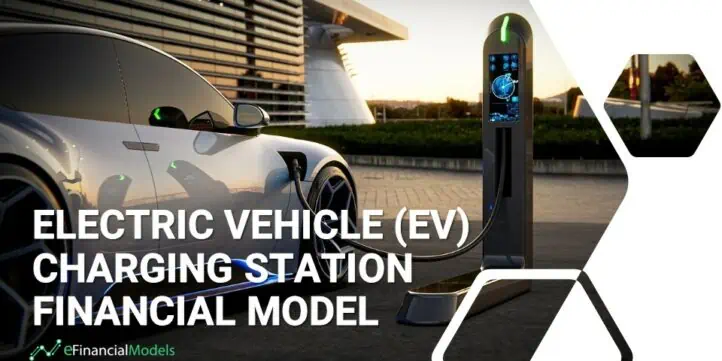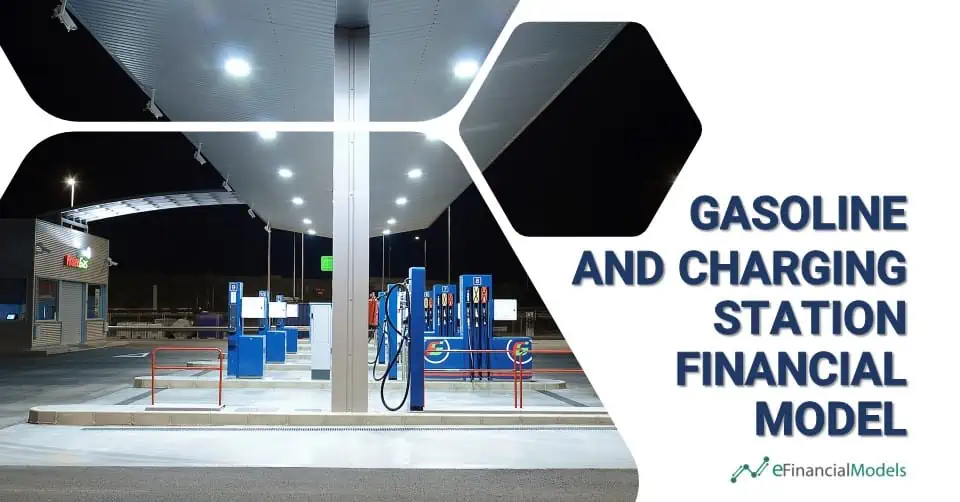Electric Vehicle (EV) Charging Station Financial Model
With this comprehensive 5- or 10-year monthly tool, investors can assess the viability of setting up and investing in an EV charging station business by forecasting revenue, costs, and cash flows and evaluating potential risks and returns. Additionally, this financial model will help investors make well-informed decisions and increase their chances of success in the growing market demand for EV charging services.

Considering that there is a transition towards sustainable transportation and growing demand for electric vehicles, investors should consider establishing an electric vehicle charging station for electric vehicles (EV). With this well-developed electric vehicle (EV) charging station financial model, investors will be provided insights into the project’s financial viability, helping them secure funding and assist in setting pricing strategies.
Furthermore, EV charging stations can generate additional revenue through convenience stores, repair stations, car washes, billboard and space rental, and other services. With the right location, marketing, and management, an EV charging station can be a profitable investment that serves the community’s needs.
The model also enables the determination of key performance indicators such as daily and monthly vehicles, average gross profit per income source, and key relevant financial metrics, including internal rate of return (IRR), minimum funding required, and the funding period.
Unique Features of this EV Charging Station Financial Model
- Charging Stations:
- Labels – Up to five charger types
- Charging Capacity – Identify power output, average charging type, and idle type to calculate available electricity volume capacity
- Expansion Schedule: To accommodate the increase in the average number of EVs, this model allows users to add an additional number of EV charging stations at a selected year.
- Electric Vehicle Analysis – Compare the available electricity volume from the required electricity of the number of vehicles to determine if the charging stations are enough.
- Units and Labels: Electricity can either be kW or MW.
- Land and Building: Users have the option to select whether land and building are owned (invested in the months of preparation) or rented (recognizes monthly rent expense)
- Forecasted Valuation: The valuation is broken down into Business and Property values. This approach enables investors to analyze better the effect of potential sale and leaseback transactions at the exit.
- Owned Scenario – Recognizes the Business value through an exit multiple (EV EBITDA) and the Property value by applying a capitalized rate to the rental value.
- Rent Scenario – Recognizes only the Business Value
- Detailed Monthly and Yearly Financial Plans: The spreadsheet is designed logically, outlining the calculations of revenues and costs, which adds to the transparency and understanding of the model.
Charging Station for EV Template Structure
This Excel template has instructions and formulas that are simple and easy to follow, which allows users to run simulations by varying the input assumptions. The elements of this financial model template are enumerated below:
Instructions and Terms contain the cell color codes, instructions guiding the user on how to work around the workbook, and the terms and abbreviations used.
Assumptions that are necessary and applicable in the business plan of starting an EV Charging Station are presented in this worksheet.
- General Settings
- Currency
- Income Tax Rate
- Investment Period
- Price and Cost Inflation Rates
- Net Working Capital
- EV Charging Station Business Assumptions
- Project Details
- EV Charging Station Time plan – Selected start year and month
- Preparation Period – Number of Months
- Opening Hours per Day
- Operating Days per Year
- Number of Electric Vehicles
- Location
- Electric Vehicle Traffic per Day
- Traffic Growth per annum
- Initial and Target No. of EV – Avg. number per day
- Ramp-Up Period – Number of months to reach Target
- Average Daily Number of EV – Allocation per Charger Type
- Project Details
- Charging Stations
- Charger Types
- Number of EV Chargers
- Purchase Cost per EV Charger
- Expansion Schedule
- Year of Expansion
- Additional Number of EV Chargers and Purchase Cost
- Power Output – kW or MW per EV Charger
- Average Charging Time – Hours per electric vehicle
- Idle Time – Hours per day
- Pricing Assumptions – Price charged per electricity sales volume
- Electricity Sources
- On-Site Power Source – Solar or Wind
- Solar or Wind Park Installed Capacity
- Investment Cost
- Specific Solar Yield or Wind Power Density
- Other Income
- Income Source
- Utilization Rate – Percentage of Vehicles
- Average Income per Vehicle
- Rental of Billboards and Spaces
- Monthly income
- Income Source
- On-Site Power Source – Solar or Wind
- Direct Costs
- Electricity Direct Costs
- Payment Processing Costs
- Other Direct Costs
- Operating Expenses
- Rent Expense (Recognized if land and building are rented)
- Employee Costs
- Supplies Expense
- Other OPEX
- Land and Building Option – Owned or Rented
- Purchase Costs if Owned
- Monthly Rent Expense
- Leasable Area
- Capital Expenditures (CAPEX) Assumptions
- CAPEX Items
- Depreciation Periods
- Initial CAPEX Investment Amount and Schedule
Users have the option to determine when CAPEX will be initially invested:
- First Month – At the beginning of the preparation period only.
- Equally Monthly – Equally throughout the preparation months
- Maintenance CAPEX – Annually or Semi-annually
- Debt Financing
- Debt Amount – Percentage (%) of CAPEX
- Sources of Debt and Allocation
- Drawdown Schedule – First Month, Equally Monthly or Investment of CAPEX Basis
- Debt Period
- Payment Term – Annually, Monthly, or Quarterly
- Interest Rate
- Grace Period – Repayment starts at a specified month/s after the preparation period.
- Equity Financing
- Injection Schedule – First Month, Equally Monthly or Investment of CAPEX Basis
- Uses and Sources of Funds
- Net Working Capital
- Cash Reserve
- Exit and Valuation
- Discount Rate
- Business Valuation
- Exit Multiple – EV EBITDA
- Property Valuation
- Capitalization Rate
- Shareholders’ Cash Flows (only in Premium Version)
- Shareholders – Up to two
- Funding and Equity Stake
- Selected Cash Flow – Levered Cash Flows or Cash In/Cash Out
- Drawdown Schedule – First Month, Equally Monthly or Investment of CAPEX Basis
- Dividend Policy
- Schedule – Start year and month
- Dividend Model – Profit Distribution or Cash Sweep
Executive Summary includes charts for a better understanding of the financial prospects of an EV Charging Station business model and to provide answers to the following questions:
- Is an EV charging station business profitable?
- How much revenue does each charger type generate?
- How many charger types for electric vehicles (EVs) are there?
- Are there enough charging stations for EVs?
This spreadsheet includes a 10-year summary of the following:
- Projected Financial Statements overview – Income Statement, Balance Sheet, and Cash Flows Statement.
- Levered and Unlevered Free Cash Flows calculating key financial feasibility metrics such as the Internal Rate of Return IRR), Payback Period, Net Present Value (NPV)
- Uses and Sources of Funds and Debt Financing
- Electric Vehicles Analysis
- Gross Profit Margin Analysis
- Forecasted Business and Property Valuation
- Shareholders’ Summary (only in Premium Version)
- Break-Even Analysis (only in Premium Version)
- This feature calculates the required average daily or yearly number of electric vehicles at the selected year to break even at an EBIT level.
- Sensitivity Analysis (only in Premium Version)
Yearly and Monthly Detailed Summary presents in charts and tables the yearly and monthly selected year overview of the Electric Vehicles (EV) Charging Station business plan.
Financials worksheet contains a comprehensive and detailed monthly 10 or 5-year (depending on the model version) forecast of the Electric Vehicles (EV) Charging Station business plan:
- Electric Vehicles (EV) Charging Station Financial Statements – Income Statement, Balance Sheet, Cash Flow Statement
- Forecasted Business and Property Valuation
- Unlevered and Levered Free Cash Flow
- Shareholders’ Cash Flows (only in Premium Version)
- This is prepared to show the calculations of the Equity Multiple and Investors’ IRR, which helps determine if their funding and equity stake percentages would result in a profit on their end.
- Funding Required
- EV Charging Stations Schedule
- CAPEX Schedule
- Debt Schedule
- Electric Vehicles
- Maximum Number based on Charger Capacity
- Average Daily Number of EV
- Electric Vehicles Analysis – Are there Enough Charging Stations for EVs?
- Electric Vehicles per Month and Year
- Electricity Volume Capacity
- Charging Stations Available Hours
- Electricity Volume Capacity per Day
- Electricity Sales Volume
- Electric Vehicles Sales
- Other Income
- Direct Costs
- Operating Expenses
- Financial Metrics
Growing Demand in Charging Stations for Electric Vehicles
This Electric Vehicle Charging Station financial template offers potential investors features that will help them analyze the effects of various scenarios and facilitate ongoing monitoring and performance tracking. This financial model also enables investors to make necessary adjustments and optimize operations.
Using a reliable financial model, investors can effectively mitigate risks, attract stakeholders, and ensure the long-term success of their EV charging station business. Obtain your copy today to start making informed decisions based on data.
This financial model template comes pre-filled with an example forecast of an Electric Vehicle Charging station business. The forecast can be easily changed by altering the blue and light blue assumptions.
The models, current version at 1.1, are available in two fully editable Excel versions:
- Premium Version (Excel file, fully editable) – All features
- Basic Version (Excel file, fully editable) – All features except for the Break-Even Analysis, Shareholder’s Cash Flow, and Sensitivity Analysis
Both versions are available in three files:
- Excel Version – pre-filled with an example forecast.
- Excel Null Version – no values in the assumption sheet.
- PDF Versions – which outline the details of the model structure.
File types:
.xlsx (MS Excel)
.pdf (Adobe Acrobat Reader)
Similar Products
Other customers were also interested in...
Gasoline and Charging Station Financial Model
Investors can assess the viability of setting up and investing in gasoline stations with a charging ... Read more
Car Rental Business Financial Model
This Car Rental Business Financial Model Template in Excel offers an ideal basis for developing a bu... Read more
Car Repair Shop Financial Model (10+ Yrs DCF and V...
The Car Repair Shop Fin. Model (DCF and Valuation) is a comprehensive tool designed to analyze the f... Read more
Electric Vehicle (EV) Charging Station Financial M...
Electric Vehicle (EV) charging Station FM helps user asses financial viability of setting up and ope... Read more
Online Car Rental – 3 Statement Financial Mo...
Online Car Rental Platform Business Plan Model is a perfect tool for a feasibility study on launchin... Read more
Driving School – 5 Year Financial Model
Financial Model providing an advanced 5-year financial plan for a startup or operating Driving Schoo... Read more
Car Wash Financial Model – Dynamic 10 Year B...
Financial Model providing a dynamic up to 10-year financial forecast for a startup or existing Car W... Read more
Parking Garage Financial Model – Dynamic 10 Year...
This Parking Garage Financial model Template enables users to get into details of every step of a Pa... Read more
Auto Repair Shop Financial Model – 5 Year Financ...
Financial Model providing an advanced 5-year financial plan for a startup or operating Auto Repair S... Read more
Car Dealership Financial Model – Dynamic 10 Year...
A car dealership, or car dealer, is a business that sells new or used cars, at the retail level, bas... Read more
You must log in to submit a review.



























